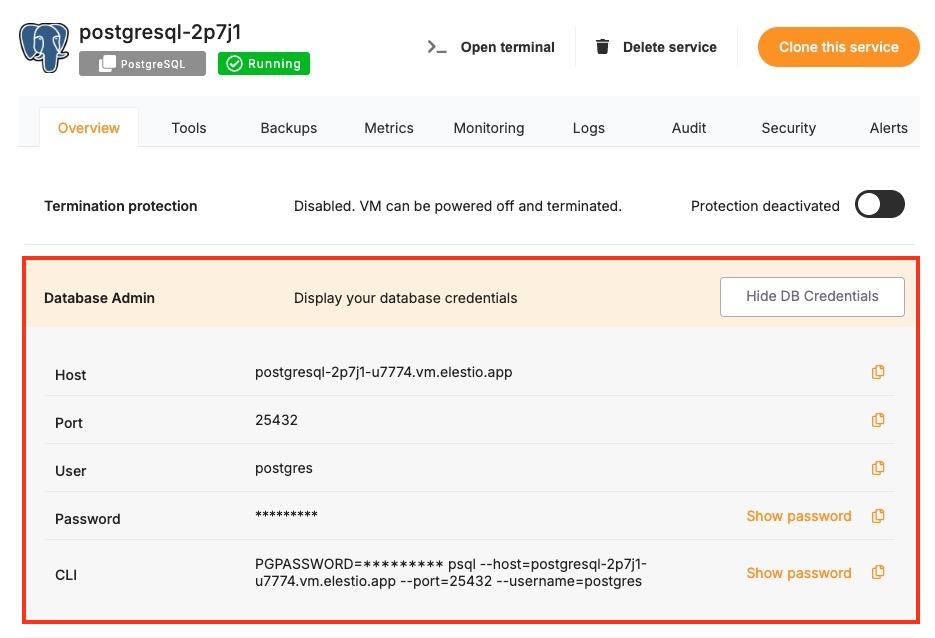Connecting with Node.js
This guide explains how to establish a connection between a Node.js application and a PostgreSQL database using the pg package. It walks through the necessary setup, configuration, and execution of a simple SQL query.
Variables
Certain parameters must be provided to establish a successful connection to a PostgreSQL database. Below is a breakdown of each required variable, its purpose, and where to find it. Here’s what each variable represents:
| Variable |
Description |
Purpose |
USER |
PostgreSQL username, from the Elestio service overview page | Identifies the database user who has permission to access the PostgreSQL database. |
PASSWORD |
PostgreSQL password, from the Elestio service overview page | The authentication key required for the specified USER to access the database |
HOST |
Hostname for PostgreSQL connection, from the Elestio service overview page | The address of the server hosting the PostgreSQL database. |
PORT |
Port for PostgreSQL connection, from the Elestio service overview page | The network port is used to connect to PostgreSQL. The default port is 5432. |
DATABASE |
Database Name for PostgreSQL connection, from the Elestio service overview page | The name of the database being accessed. A PostgreSQL instance can contain multiple databases. |
These values can usually be found in the Elestio service overview details as shown in the image below, make sure to take a copy of these details and add it to the code moving ahead.
Prerequisites
-
Install Node.js and NPM
- Check if Node.js is installed by running:
- If not installed, download it from nodejs.org and install.
- Verify npm installation:
-
Install the
pgPackage
Thepgpackage enables Node.js applications to interact with PostgreSQL. Install it using:
Code
Once all prerequisites are set up, create a new file named pg.js and add the following code:
const pg = require("pg");
// Database connection configuration
const config = {
user: "USER",
password: "PASSWORD",
host: "HOST",
port: "PORT",
database: "DATABASE",
};
// Create a new PostgreSQL client
const client = new pg.Client(config);
// Connect to the database
client.connect((err) => {
if (err) {
console.error("Connection failed:", err);
return;
}
console.log("Connected to PostgreSQL");
// Run a test query to check the PostgreSQL version
client.query("SELECT VERSION()", [], (err, result) => {
if (err) {
console.error("Query execution failed:", err);
client.end();
return;
}
console.log("PostgreSQL Version:", result.rows[0]);
// Close the database connection
client.end((err) => {
if (err) console.error("Error closing connection:", err);
});
});
});
To execute the script, open the terminal or command prompt and navigate to the directory where pg.js. Once in the correct directory, run the script with the command
node pg.jsIf the connection is successful, the terminal will display output similar to:
Connected to PostgreSQL
PostgreSQL Version: {
version: 'PostgreSQL 16.8 (Debian 16.8-1.pgdg120+1) on x86_64-pc-linux-gnu, compiled by gcc (Debian 12.2.0-14) 12.2.0, 64-bit'
}
